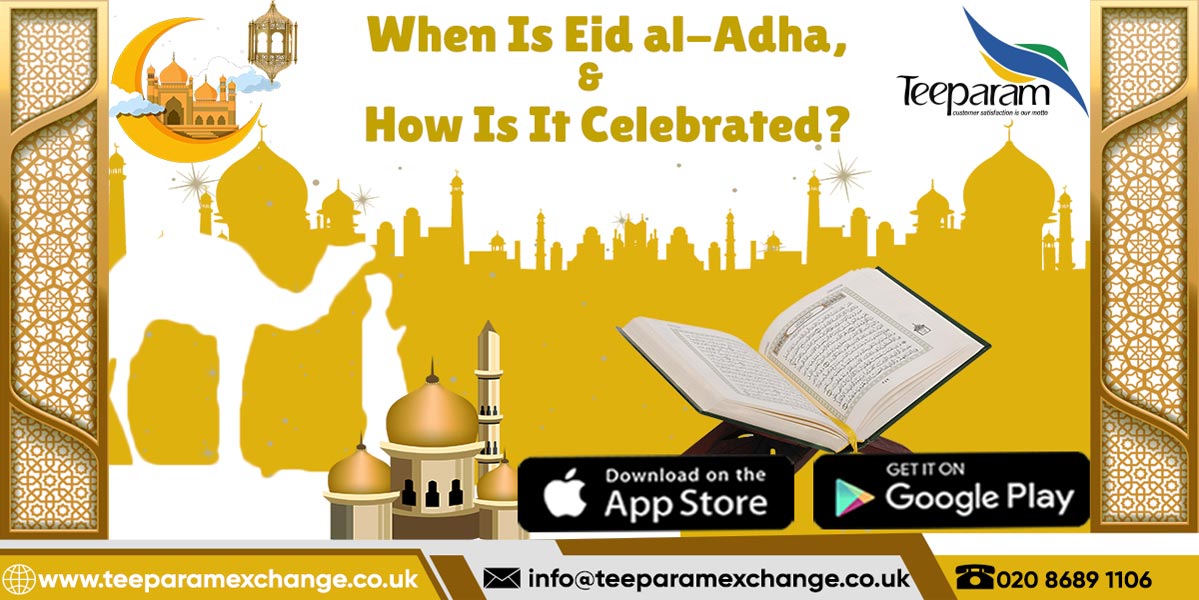
When Is Eid al-Adha, and How Is It Celebrated?
Are you a Non-Islamic but interested in Muslim culture and their festivals? Do you enjoy their festivals or special dishes so much and wondering when can you taste them back. Or are you someone living in an Islamic country and wanted to know about how their festivals and holidays fall? Then you must be curious to know all about Eid al-adha, when it is celebrated and how.
What is Eid al-Adha?
Eid al-Adha, also known as the "Festival of Sacrifice" or "Greater Eid," is one of the most important religious holidays celebrated by Muslims worldwide. It commemorates the willingness of Prophet Ibrahim (Abraham) to sacrifice his son as an act of obedience to God.
It is known as the second major festival for Muslims. The holiday lasts for four days and is considered a time of great significance and spiritual importance for Muslims.
When is Eid al-Adha?
The date of Eid al-Adha is determined according to the Islamic lunar calendar, which is based on the sighting of the moon. It falls on the 10th day of Dhul Hijjah, the 12th and last month of the Muslim lunar calendar.
The Origin
The origin of Eid al-Adha can be traced back to the story of Ibrahim (Abraham in the Judeo-Christian tradition) as described in the Islamic religious texts, particularly the Quran and the Hadiths (the sayings and actions of the Prophet Muhammad).
According to Islamic tradition, Ibrahim was a prophet and a devoted servant of God. He and his wife Sarah were childless for many years until they were blessed with a son named Ismail (Ishmael). Ibrahim loved his son deeply and, at God's command, he was put to a great test to demonstrate his faith and obedience.
In the story, Ibrahim received a divine command in a dream, where he was instructed to sacrifice his son as a test of his devotion. Initially, Ibrahim thought it was a command from Satan, but the dream persisted, indicating it was a divine command. Both Ibrahim and Ismail willingly submitted to God's will and prepared for the sacrifice.
However, as Ibrahim was about to carry out the sacrifice, God intervened and replaced Ismail with a ram to be sacrificed instead. This act demonstrated Ibrahim's unwavering faith and willingness to sacrifice what was most dear to him for the sake of God.
The story of Ibrahim's sacrifice is seen as a symbol of absolute obedience, faith, and submission to God's commands. It serves as a reminder for Muslims to prioritize their devotion to God above all else and to be willing to make sacrifices in their lives. Eid al-Adha, the "Festival of Sacrifice," commemorates this event and is celebrated annually to honor Ibrahim's unwavering faith and the mercy and blessings of God. It is a time for Muslims to reflect on the values of sacrifice, charity, and unity, as well as to strengthen their relationship with God and their community.
End of Hajj
The end of Hajj, the annual Islamic pilgrimage to the holy city of Mecca in Saudi Arabia, is marked by the celebration of Eid al-Adha, also known as the "Festival of Sacrifice." Hajj is considered one of the five pillars of Islam and holds great religious significance for Muslims worldwide.
Hajj takes place during the Islamic month of Dhu al-Hijjah, specifically from the 8th to the 12th or 13th day of the month. The exact dates of Hajj vary each year according to the Islamic lunar calendar. The culmination of the Hajj pilgrimage occurs on the 10th day of Dhu al-Hijjah, known as the Day of Arafah.
On the Day of Arafah, pilgrims gather at Mount Arafat, a vast plain located outside Mecca. They spend the day engaged in prayer, supplication, and reflection. It is believed that standing on the plains of Arafat and performing the rituals at this location is a crucial aspect of Hajj, as it symbolizes the gathering of all Muslims before God and the Day of Judgment.
After sunset on the Day of Arafah, the pilgrims move to the nearby area of Muzdalifah, where they spend the night in prayer and gather pebbles for the next ritual. The following day, known as Eid al-Adha, the pilgrims return to Mina, a tent city near Mecca, to perform the symbolic stoning of the devil. They throw pebbles at three pillars known as the Jamarat, representing the devil's temptation faced by Ibrahim during his test.
The days following Eid al-Adha are known as the days of Tashreeq, during which the pilgrims continue their rituals, including the stoning of the pillars and performing additional prayers. They also engage in the symbolic act of animal sacrifice to commemorate Ibrahim's willingness to sacrifice his son, as mentioned earlier.
The end of Hajj is marked by the completion of these rituals, and pilgrims begin to return to their homes or continue their journey for further religious and personal activities. It is a time of joy, reflection, and gratitude for having had the opportunity to fulfill one of the most significant obligations in Islam.
How is Eid al-Adha is celebrated?
Eid al-Adha, the "Festival of Sacrifice," is celebrated by Muslims worldwide with joy, gratitude, and acts of devotion.
Special Prayers
Muslims start the day by attending special congregational prayers at mosques or outdoor prayer grounds. These prayers, known as Eid prayers or Salat al-Eid, are led by an Imam and include specific supplications and recitations.
Sermons and Reflection
Following the prayers, sermons are delivered by religious leaders, emphasizing the significance of Eid al-Adha, the values of sacrifice, and other relevant spiritual teachings. Muslims listen attentively and reflect on the messages shared.
Animal Sacrifice
One of the central rituals of Eid al-Adha is the sacrifice of an animal, typically a sheep, goat, cow, or camel. This sacrifice is carried out following the example of Ibrahim's willingness to sacrifice his son. The meat from the sacrificed animal is divided into three parts: one-third is given to the needy, one-third is shared with friends and family, and one-third is kept for the household.
Festive Meals
After the sacrifice, Muslims prepare and enjoy festive meals with family, friends, and the community. Special dishes and traditional foods are prepared, and people come together to share the joy of the occasion. It is a time of hospitality and generosity, with guests often invited to partake in the celebratory meals.
Giving Gifts
It is common for Muslims to exchange gifts during Eid al-Adha as a way of expressing love, appreciation, and unity. Children especially look forward to receiving presents and new clothes during this festive time.
Visiting and Reconnecting
Eid al-Adha is a time for Muslims to visit family, friends, and neighbors. People often dress in their finest attire and make social visits, strengthening relationships and fostering a sense of community.
Acts of Charity
Eid al-Adha emphasizes the importance of generosity and helping those in need. Muslims are encouraged to give to charity and engage in acts of kindness and service during this time. Donating to the less fortunate and participating in community initiatives are common ways of practicing charity during Eid al-Adha.
Enjoyment and Recreation
In many cultures, Eid al-Adha is a time of celebration and enjoyment. People engage in recreational activities, such as going to amusement parks, organizing community events, participating in sports, or spending time outdoors with family and friends.
Eid al-Adha is a significant Islamic holiday celebrated by Muslims around the world. During Eid al-Adha, Muslims participate in various religious and festive activities.
Eid al-Adha is also a time for joy, celebration, and social gatherings. Muslims dress in their finest attire, exchange gifts, and enjoy festive meals together. Visiting family, friends, and neighbors is common, fostering a sense of community and unity.
Acts of charity and service are encouraged during Eid al-Adha, emphasizing the importance of generosity and helping those in need. Muslims engage in acts of kindness and donate to charitable causes.
While the core elements of Eid al-Adha remain consistent, specific customs and traditions may vary across different cultures and regions. Nonetheless, the overall spirit of the holiday centers around gratitude, worship, community, and acts of compassion.
Eid al-Adha is a time for Muslims to express their devotion to God, strengthen family and community bonds, and extend a helping hand to those less fortunate. It serves as a reminder of the values and teachings of Islam, promoting unity, compassion, and selflessness.
Hope now you have got an idea on what is Eid al-adha and how it is celebrated. And if you are sending money online always remember our sri lanka exchange rate is the highest in the UK market.








